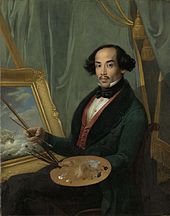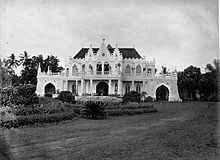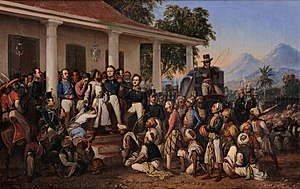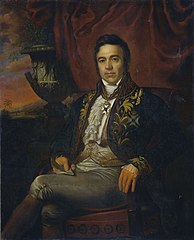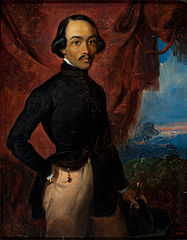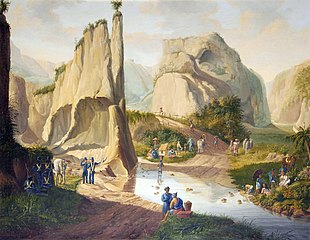
The kris, or keris in the Indonesian languages, is an Indonesian asymmetrical dagger, both weapon and spiritual object, with distinctive blade-patterning achieved through alternating laminations of iron and nickelous iron (pamor). Of Javanese origin, the kris is famous for its distinctive wavy blade, although many have straight blades as well, and is one of the weapons commonly used in the pencak silat martial art, native to Indonesia.

Batu, officially the City of Batu, is a landlocked city in the East Java Province of Indonesia. It is about 20 km to the northwest of Malang. Formerly, it was a part of Malang Regency; but on 21 June 2001, Batu became an independent city, with its own mayor and council.

Prince Diponegoro, also known as Dipanegara, was a Javanese prince who opposed the Dutch colonial rule. The eldest son of the Yogyakartan Sultan Hamengkubuwono II, he played an important role in the Java War between 1825 and 1830. After his defeat and capture, he was exiled to Makassar, where he died, 69 years old.
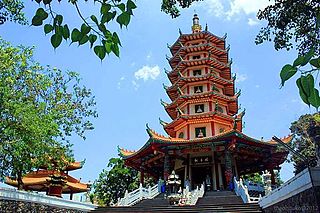
Semarang is the capital and largest city of Central Java province in Indonesia. It was a major port during the Dutch colonial era, and is still an important regional center and port today. The city has been named as the cleanest tourist destination in Southeast Asia by the ASEAN Clean Tourist City Standard (ACTCS) for 2020–2022.

The Java War or Diponegoro War (ꦥꦼꦫꦁꦢꦶꦥꦤꦼꦒꦫ) was fought in central Java from 1825 to 1830, between the colonial Dutch Empire and native Javanese rebels. The war started as a rebellion led by Prince Diponegoro, a leading member of the Javanese aristocracy who had previously cooperated with the Dutch.

The Merdeka Palace, is one of six presidential palaces in Indonesia. It is located on the north side of the Merdeka Square in Central Jakarta, Indonesia and is used as the official residence of the president of the Republic of Indonesia.
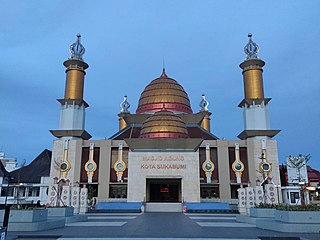
Sukabumi is a landlocked city surrounded by the regency of the same name in the southern foothills of Mount Gede, in West Java, Indonesia, about 100 km (62 mi) south of the national capital, Jakarta.

Raden Mas Soewardi Soerjaningrat ; from 1922 also known as Ki Hadjar Dewantara, which is also written as Ki Hajar Dewantoro to reflect its Javanese pronunciation, was a leading Indonesian independence movement activist, writer, columnist, politician, and pioneer of education for native Indonesians in Dutch colonial times. He founded the Taman Siswa school, an institution that provided education for indigenous commoners, which otherwise was limited to the Javanese aristocracy and the Dutch colonials.

Peter Carey is a British historian and author who specialises in the modern history of Indonesia, Java in particular, and has also written on East Timor and Myanmar. He was the Laithwaite fellow of Modern History at Trinity College, Oxford, from 1979 to 2008. His major early work concentrated on the history of Diponegoro, the British in Java, 1811–16 and the Java War (1825–30), on which he has published extensively. His biography of Diponegoro, The Power of Prophecy, appeared in 2007, and a succinct version, Destiny; The Life of Prince Diponegoro of Yogyakarta, 1785–1855, was published in 2014. He has conducted research in Lisbon and the United Kingdom amongst the exile East Timorese student community for an oral history of the Indonesian occupation of East Timor, 1975–99, part of which was published in the Cornell University journal Indonesia.

Surakarta Sunanate is a Javanese monarchy centred in the city of Surakarta, in the province of Central Java, Indonesia.
Cikini is an administrative village in the Menteng district of Indonesia. It has a postal code of 10330. Cikini has a long history that goes all the way back to the colonial period and still there are many structures which were built during colonial period. The area is developed as a tourist destination by Jakarta city administration.
Friedrich Carl Albert Schreuel, also known as Frederik Karel Albert Schreuel and Jan Christian Aelbert Schreuel, was a Dutch-born painter.

The Submission of Prince Dipo Negoro to General De Kock is an oil painting on canvas painted by Nicolaas Pieneman between 1830 and 1835. It depicts, from a victorious Dutch colonial perspective, the capture of Prince Diponegoro in 1830, which signaled the end of the Java War (1825–1830).

The Arrest of Pangeran Diponegoro is the name of an 1857 painting by Raden Saleh, depicting the capture of Prince Diponegoro by Lieutenant General Hendrik Merkus de Kock on 28 March 1830.

The French and British interregnum in the Dutch East Indies of the Dutch East Indies took place between 1806 and 1816. The French ruled between 1806 and 1811, while the British took over for 1811 to 1816 and transferred its control back to the Dutch in 1816.

Josias Cornelis Rappard was a Dutch soldier and artist. Some of his paintings were made into lithographs and illustrations. He spent time in Indonesia and made artworks there.

Indies Empire style is an architectural style that flourished in the colonial Dutch East Indies between the middle of the 18th century and the end of the 19th century. The style is an imitation of neoclassical Empire Style which was popular in mid-19th-century France. Conformed to the tropical setting of Indonesia, the style became known in the Dutch East Indies as Indies Empire style.

It is quite difficult to define Indonesian art, since the country is immensely diverse. The sprawling archipelago nation consists of 17.000 islands. Around 922 of those permanently inhabited, by over 1,300 ethnic groups, which speak more than 700 living languages.

Indonesian painting has a very long tradition and history in Indonesian art, though because of the climatic conditions very few early examples survive, Indonesia is home to some of the oldest paintings in the world. The earliest Indonesian paintings were the rock paintings of prehistoric times, such as the petroglyphs found in places like in the caves in the district of Maros in Sulawesi, Indonesia. The Stone Age rock paintings found in Maros Cave are approximately 40,000 years old and are listed as one of the oldest paintings in the world.
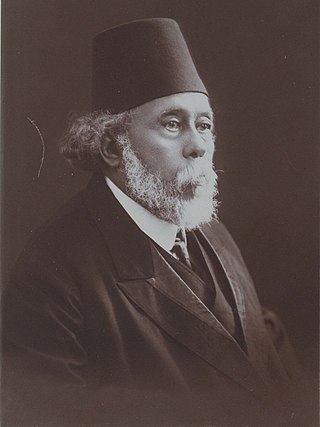
Sayyid Abdullah bin Alwi Alatas was a Dutch East Indies merchant, landlord, and philanthropist of Arab descent from the Ba 'Alawi sada clan. Alatas is also the owner of the Cikini House after it was bought from Raden Saleh. He also inherited another eccentric house, such as a house built by a Frenchman in an Islamic style.

